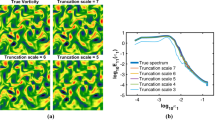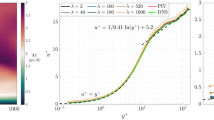Abstract
This manuscript details recent improvements in a wavelet-based optical flow velocimetry (wOFV) method that represents a more physically sound implementation and results in increased accuracy of the velocity estimation. A novel regularization scheme is presented that is based on penalization of directional derivatives of the estimated velocity field or more specifically, second-order penalization of the gradients of divergence and curl, which enforces realistic flow structure. The regularization is performed in the wavelet domain with symmetric boundary conditions for the first time using an alternative wavelet transform approach of matrix multiplications. The method for the computation of full two-dimensional wavelet transforms by a single pair of matrix multiplications is described and shown to be significantly more efficient than a lifting implementation or convolution in MATLAB. Velocity fields are estimated from synthetic tracer particle images generated from 2D DNS of isotropic turbulence and from experimental results from a turbulent flow. Results are compared to an advanced correlation-based PIV algorithm and previous advanced optical flow methods. The velocity results estimated with the new regularization scheme are shown to be more accurate and exhibit a significant reduction in non-physical small-scale artifacts compared to previous results. A significant result from the current method is the ability to generate 2D velocity field images that resolve the dissipative scales in high-Reynolds number, turbulent flows.
Graphic abstract










Similar content being viewed by others
Notes
The use of non-periodic boundary conditions are important for experimental data and are used in the current wOFV implementation regardless of evaluating synthetic or experimental data.
References
Adrian RJ, Westerweel J (2011) Particle image velocimetry. Cambridge University Press, Cambridge
Atcheson B, Heidrich W, Ihrke I (2009) An evaluation of optical flow algorithms for background oriented schlieren imaging. Exp Fluids 46(3):467
Bernard CP (2001) Discrete wavelet analysis for fast optic flow computation. Appl Comput Harmon Anal. https://doi.org/10.1006/acha.2000.0341
Beylkin G (1992) On the representation of operators in bases of compactly supported wavelets. SIAM J Numer Anal 6(6):1716
Cai S, Mémin E, Dérian P, Xu C (2018) Motion estimation under location uncertainty for turbulent fluid flows. Exp Fluids 59:8
Cai S, Zhou S, Xu C, Gao Q (2019) Dense motion estimation of particle images via a convolutional neural network. Exp Fluids. https://doi.org/10.1007/s00348-019-2717-2
Carlier J, Wieneke B (2005) Report 1 on production and diffusion of fluid mechanics images and data. Tech. rep., Fluid image analysis and description (FLUID) Project. http://fluid.irisa.fr/data-eng.htm
Cassisa C, Simoens S, Prinet V, Shao L (2011) Subgrid scale formulation of optical flow for the study of turbulent flows. Exp Fluids 51(6):1739
Chen X, Zillé P, Shao L, Corpetti T (2015) Optical flow for incompressible turbulence motion estimation. Exp Fluids. https://doi.org/10.1007/s00348-014-1874-6
Coifman RR, Donoho DL (1995) Wavelets and statistics, Chap. translation-invariant de-noising. Springer, New York, pp 125–150. https://doi.org/10.1007/978-1-4612-2544-7_9
Corpetti T, Mémin E, Pérez P (2002) Dense estimation of fluid flows. IEEE Trans Pattern Anal Mach Intell 24(3):365
Corpetti T, Heitz D, Arroyo G, Mémin E, Santa-Cruz A (2006) Fluid experimental flow estimation based on an optical-flow scheme. Exp Fluids 40(1):80. https://doi.org/10.1007/s00348-005-0048-y
Dérian P (2012) Wavelets and fluid motion estimation. Ph.D. thesis, Université de Rennes
Dérian P, Almar R (2017) Wavelet-based optical flow estimation of instant surface currents from shore-based and UAV videos. IEEE Trans Geosci Remote Sens 55(10):5790
Dérian P, Héas P, Herzet C, Mémin E (2012) In scale space and variational methods in computer vision. In: Romeny BM, Bronstein AM, Bronstein MM (eds) SSVM 2011, vol 6667. Springer, New York
Dérian P, Héas P, Herzet C, Mémin E (2013) Wavelets and optical flow motion estimation. Numer Math Theory Methods Appl 6:116
Héas P, Herzet C, Mémin E, Heitz D, Mininni PD (2013) Bayesian estimation of turbulent motion. IEEE Trans Pattern Anal Mach Intell 35(6):1343
Héas P, Lavancier F, Kadri-Harouna S (2014) Self-similar prior and wavelet bases for hidden incompressible turbulent motion. SIAM J Imaging Sci 7(2):1171
Héas P, Mémin E, Heitz D, Mininni PD (2012) Power laws and inverse motion modelling: application to turbulence measurements from satellite images. Tellus A Dyn Meteorol Oceanogr. https://doi.org/10.3402/tellusa.v64i0.10962
Horn BKP, Schunck BG (1981) Determining optical flow. Artif Intell 17:185
Kadri-Harouna S, Dérian P, Héas P, Mémin E (2013) Divergence-free wavelets and high order regularization. Int J Comput Vision 103(1):80. https://doi.org/10.1007/s11263-012-0595-7
Kähler CJ, Scharnowski S, Cierpka C (2012) On the resolution limit of digital particle image velocimetry. Exp Fluids 52(6):1629
Liu T (2017) OpenOpticalFlow: an open source program for extraction of velocity fields from flow visualization images. J Open Res Softw. https://doi.org/10.5334/jors.168
Liu T, Shen L (2008) Fluid flow and optical flow. J Fluid Mech 614:253. https://doi.org/10.1017/S0022112008003273
Liu T, Merat A, Makhmalbaf MHM, Fajardo C, Merati P (2015) Comparison between optical flow and cross-correlation methods for extraction of velocity fields from particle images. Exp Fluids 56:166
Luff JD, Drouillard T, Rompage AM, Linne MA, Hertzberg JR (1999) Experimental uncertainties associated with particle image velocimetry (PIV) based vorticity algorithms. Exp Fluids 26:36. https://doi.org/10.1007/s003480050263
Mallat SG (1989) Multiresolution approximations and wavelet orthonormal bases of L\(^2\)(R). Trans Am Math Soc 315(1):69–87
Mallat SG (2009) A wavelet tour of signal processing. Elsevier, Amsterdam
Marino F, Piuri V, Swartzlander EE (1999) A parallel implementation of 2-D discrete wavelet transform without interprocessor communications. IEEE Trans Signal Process. https://doi.org/10.1109/78.796458
Mojsilovic A, Popovic M, Markovic S, Krstic M (1998) Characterization of visually similar diffuse diseases from B-scan liver images using nonseparable wavelet transform. IEEE Trans Med Imaging. https://doi.org/10.1109/42.730399
Pope SB (2001) Turbulent flows. IOP Publishing, Bristol
Raffel M, Willert CE, Scarano F, Kähler CJ, Wereley ST, Kompenhans J (2018) Particle image velocimetry: a practical guide. Springer, New York
Regert T, Tremblais B, David L (2010) Parallelized 3D optical flow method for fluid mechanics applications. In: Fifth international symposium on 3D data processing, visualization and transmission
Ruhnau P, Schnörr C (2007) Optical Stokes flow estimation: an imaging-based control approach. Exp Fluids. https://doi.org/10.1007/s00348-006-0220-z
Schmidt BE, Sutton JA (2019) High-resolution velocimetry from tracer particle fields using a wavelet-based optical flow method. Exp Fluids. https://doi.org/10.1007/s00348-019-2685-6
Skiba AW, Wabel TM, Carter CD, Hammack SD, Temme JE, Driscoll JF (2018) Premixed flames subjected to extreme levels of turbulence part I: Flame structure and a new measured regime diagram. Combust Flame 189:407
Smith L (1998) Linear algebra, chap. representing linear transformations by matrices. Springer, New York. https://doi.org/10.1007/978-1-4612-1670-4_11
Strassen V (1969) Gaussian elimination is not optimal. Numer Math. https://doi.org/10.1007/BF02165411
Tikhonov AN, Arsenin VI (1977) Solutions of ill-posed problems, vol 14. Vh Winston, Washington, DC
Wu Y, Kanade T, Li C, Cohn J (2000) Image registration using wavelet-based motion model. Int J Comput Vision 38(2):129
Yuan J, Schnörr C, Mémin E (2007) Discrete orthogonal decomposition and variational fluid flow estimation. J Math Imaging Vision 28:67
Zillé P, Corpetti T, Shao L, Chen X (2014) Observation model based on scale interactions for optical flow estimation. IEEE Trans Image Process 23(8):3281
Acknowledgements
The current work was partially supported by the Air Force Office of Scientific Research (Grant FA9550-16-1-0366; Dr. Chiping Li, Program Officer). The authors thank Pierre Dérian for helpful discussions clarifying the implementation of the regularization scheme in his work and Julia Dobrosotskaya for helping the authors frame the representation of wavelet transforms as matrix multiplications in an appropriate mathematical context. Finally, the authors thank Aaron Skiba, Campbell Carter, and Steve Hammack for providing the experimental particle image data used in the current work.
Author information
Authors and Affiliations
Corresponding author
Additional information
Publisher's Note
Springer Nature remains neutral with regard to jurisdictional claims in published maps and institutional affiliations.
This work was partially sponsored by the Air Force Office of Scientific Research under grant FA9550-16-1-0366 (Chiping Li, Program Manager).
Rights and permissions
About this article
Cite this article
Schmidt, B.E., Sutton, J.A. Improvements in the accuracy of wavelet-based optical flow velocimetry (wOFV) using an efficient and physically based implementation of velocity regularization. Exp Fluids 61, 32 (2020). https://doi.org/10.1007/s00348-019-2869-0
Received:
Revised:
Accepted:
Published:
DOI: https://doi.org/10.1007/s00348-019-2869-0




